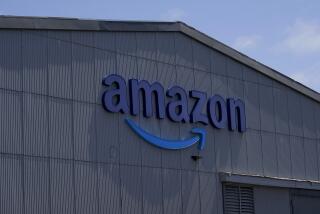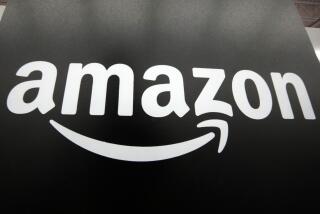Amazon Acts as Guide in Online Retail Jungle
- Share via
Amazon.com Inc. is helping customers find something surprising this holiday season: its retail rivals.
Nearly a decade after it wowed millions with online shopping, Amazon is betting that the big money on the Web these days lies in connecting buyers and sellers, not necessarily in selling stuff directly.
So when Amazon shoppers search for computers, the results might include a link to Dell Inc.’s online shopping site. Browsing for Ralph Lauren duds could get you connected to fashion retailer Bluefly Inc. A digital camera sold by J&R; Music and Computer World is sometimes displayed more prominently than the same one sold by Amazon.
The people at Amazon think there’s money to be made in not making sales. In fact, this virtual store is rapidly resembling a virtual mall. Its rent is the commission other retailers pay to have traffic steered their way.
“We wanted to position ourselves as the place to start for shopping,” said Diego Piacentini, Amazon’s senior vice president of worldwide retail and marketing. “The strategy is to keep connecting people with products.”
Chief Executive Jeff Bezos launched Amazon.com in 1995 as an online bookseller. Before long, it was selling movies, CDs, toys and consumer electronics. Then came tools, sporting goods, jewelry and more.
Amazon executives realized they could offer everything under the sun without having to actually buy, store, sell and ship those products.
“They decided they didn’t want to be the Wal-Mart of the Web,” said Mark Mahaney, an analyst with American Technology Research. “At one point they did have very grandiose plans to be the direct retailer on all the products, but they realized it’s very hard to do and the economics aren’t there.”
The first step in Amazon’s new strategy was the third-party seller program, launched in 2000. Inspired by EBay Inc.’s sprawling marketplace, Amazon lets more than 800,000 sellers hawk their goods on its website in exchange for a cut of all sales. Most are individuals looking to unload used books or CDs. Others are established bricks-and-mortar retailers like Office Depot Inc. and Foot Locker Inc. eager to tap into Amazon’s base of 44 million active customers.
Amazon won’t say what portion of its expected $6.7 billion to $6.9 billion in revenue this year will come from third-party sales. But the program is growing: 28% of Amazon’s third-quarter unit sales were from such sellers, up from 22% the same period last year.
Not all Wall Street analysts approve of Amazon’s strategy. Banc of America Securities analyst Aram Rubinson recently slapped a “sell” rating on Amazon, arguing that it’s acting a lot more like a traditional retailer than an Internet company. He cited Amazon’s gross margin of 23.5%, which is just below Wal-Mart Stores Inc.’s 23.8% and less than a third of EBay’s whopping 80.8%.
Rubinson said the rationale behind the third-party program eluded him.
“We understand the economics are attractive,” he wrote in a research note, “but rarely do successful retailers outsource the customer experience -- especially one so keen on owning the customer as Amazon.”
Amazon’s Piacentini pooh-poohed Rubinson’s argument as old-fashioned, saying the company guarantees orders placed through its merchant partners and lets users post reviews of each seller to maintain customers’ trust.
“The Internet is changing so many rules,” he said. “We need to be ahead of the curve and driving the customer experience in this direction.”
The program is a boon to specialty retailers such as Santa Monica-based Cooking.com Inc.
“We’re getting our brand and our products displayed to people who may not have found it otherwise,” said Chief Executive Tracy Randall, who attributes 7% to 9% of the company’s sales to Amazon traffic.
Influenced heavily by the booming online market for search-related ads, Amazon last year started running Google Inc.’s targeted ads when customers searched for products. For example, a query for “bread maker” pulls up not only a page of bread makers that Amazon sells but also “sponsored links” to similar gadgets on the websites of Cooking.com and Williams-Sonoma Inc.
Amazon gets paid only if Web surfers click on the link. And if customers visit Cooking.com and decide to buy Amazon’s bread maker instead, it gets paid twice -- once by Cooking.com for the referral and again by the customer.
It doesn’t stop there. Even if customers click on Amazon’s top offering, the Breadman TR2200C, they have plenty of other chances to buy from somewhere other than Amazon.
Clicking the “ready to buy” box, in blue on the right side of the page, recently took customers to WholesalersClub.com -- because the Mentor, Ohio, e-tailer offered the lowest price. Amazon’s offering appeared second.
The third-party sales and keyword ads highlight Amazon’s strategy: It tries to sell its products at the lowest price on the Web. But if it’s undercut or doesn’t have the item in stock, Piacentini said, Amazon still gets a commission, which it in turn uses to drive prices lower.
“It will definitely help margins,” said Rob Plaza, a senior equity analyst with Zacks Investment Research in Chicago. “The question is how many incremental sales they add because of it.”
Most of Amazon’s online competitors are happy to take Amazon’s referrals -- Amazon can tell Google to block some competitors -- but some are reluctant to return the favor. That’s because many of the bigger players are Internet divisions of bricks-and-mortar chains, such as Circuit City Stores Inc., Best Buy Co. and Wal-Mart.
“We don’t want to clutter up our site with a lot of advertising,” said Carter Cast, senior vice president of merchandising and marketing for Walmart.com, the retail giant’s Brisbane, Calif.-based Internet division.
Wal-Mart, the world’s largest retailer with annual sales of $259 billion, is more interested in driving traffic to its offline stores than to rival websites willing to pay a commission. That’s because offline sales still dwarf online sales. Although e-commerce sales rose 21% in the third quarter to $16.5 billion, they constituted only 1.8% of the $923 billion in total sales.
“Our strategy is very different than Amazon’s,” Cast said. “We certainly respect what they’ve done for the category. But our role is to build a bridge for Wal-Mart customers to Wal-Mart stores, and that’s how we evaluate ourselves.”
At least one Internet-only retailer is starting to follow Amazon’s lead. Buy.com Inc., an Orange County online retailer, this month started putting Google ads on its website and plans to launch its own third-party seller program. Chief Executive Scott Blum is betting that if people follow the links to a competing site, they’ll come back to make the purchase.
“Amazon’s the one that opened my eyes to this,” he said.
He added that Buy.com wouldn’t allow all of its competitors’ Google ads to appear. One whose ads definitely won’t: Amazon.
More to Read
Inside the business of entertainment
The Wide Shot brings you news, analysis and insights on everything from streaming wars to production — and what it all means for the future.
You may occasionally receive promotional content from the Los Angeles Times.










